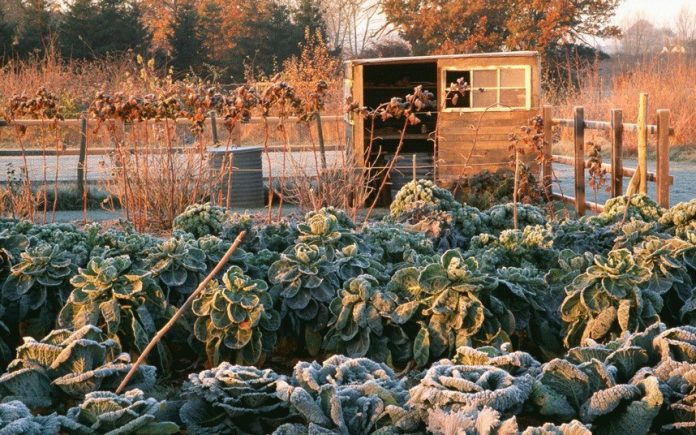First let’s give a nod at the growing zones that are just entering or hitting the main strides of their production seasons. Best of luck to you!
For many of us in the northern hemisphere, growing season is winding down. We may be extending our production with row covers, greenhouses, indoor veggies and greens, and sprouts, or we may be hanging up our gloves for a complete break.
Winter or summer, anytime we’re going to let our gardens or some portion of them go dormant, some simple preparations can help lower our workloads and increase their productivity for the next season.
Test Now
While things can change due to soil activity and temperature, even if you’re already getting frosts or snows, go ahead and test your soil pH and nutrients. You can do basic tests at home for very little cost. Most extension services also offer testing, including a battery for micro-nutrients using plant matter, so call around to see if that’s an option.

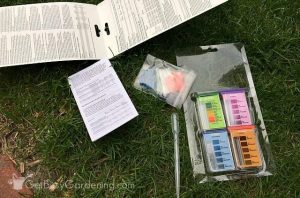

Most amendments, especially on the pH and major deficiency fronts, do best if they have some time to groove before planting. If you’re making significant changes, it’s usually recommended to do so incrementally verses dumping tons in one go. The faster we know about a trend, the faster we can address it and get back to max productivity.
*Don’t ignore this one if you have pots and planters – they’re as vulnerable as raised beds and can benefit just like beds and row-crop plots.
Spread & Start Compost
Fertilizing early also applies to compost, finished or partially finished, or raw.
Trench, hole and tube composting in-situ allows microbes to work over raw materials through the verges of our seasons. Spreading finished or partially finished compost on the surface also allows nutrients to permeate downward and for microbes and beneficial insects to work it into the surface.
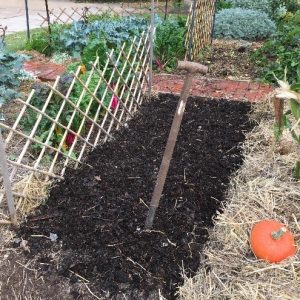
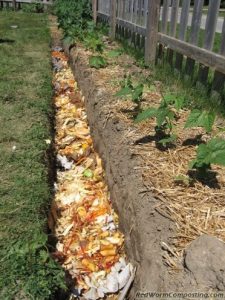
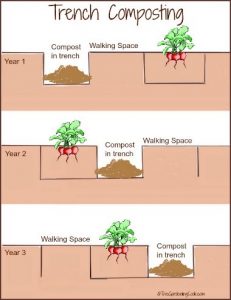
We can also go ahead and till or fork finished or partially finished compost into the surface of soils for the same effects. Soil will be better conditioned at the start of planting.
Composting materials – to include the “safe” manures – can also help us if we use greenhouses, cold frames, or plastic row covers. Composting requires some warmth, but it also generates heat of its own. By doing pits or trenches to fill with compost, we can actually extend the growing season for some of our tenders and our cold-hardy crops.
The compost that develops over autumn and winter will be ready to help feed areas of the garden that need a spring boost. In cool areas where it won’t completely finish, it’ll still be speeding up the process for us.
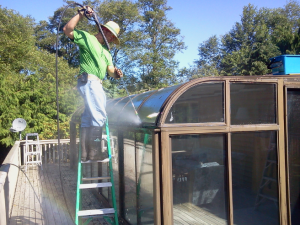

Greenhouses
Wash off any dust or pollen that’s built up on the roof or sides through the season to maximize the sunlight plants will be getting. A pressurized hose nozzle or power washer can also remove the leaves that will or are already falling.
Don’t neglect the interior. Greenhouse glass or plastic can end up coated by “hard water” and “soap scum” mineral deposits as condensation and irrigation spray evaporates, reducing the amount of light that gets through.
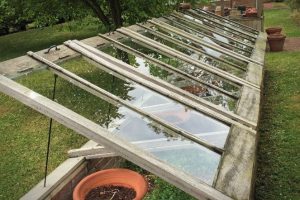
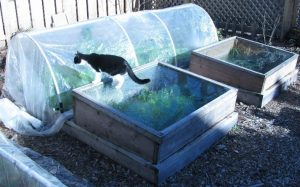
Outdoor cold frames and row cover plastic can be more difficult, but can also benefit from spraying or brushing off pollen and dirt, mild solutions to remove evaporation buildup, and some visual inspections for wear, holes, and rips.
This is also an excellent time to check for holes in screens and drafts in window joints and at the door(s). Adding reflectors and heat sinks like black hoses, buckets, and bottles filled with water can further extend seasons.
Clean-up season can also be a good time to run disinfectant protocols and check preps for winter-spring greenhouse pests.
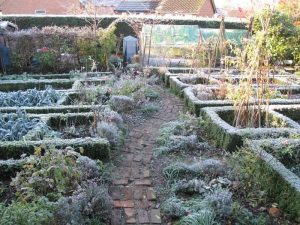
Gardens Like Cozying Up Under Blankets, Too
One of the biggest, easiest boosts comes from leaving as little bare, flattened earth as possible over our dormant season. Cover crops and a specific way of tilling for sloped areas gets covered in a bit, but one of the most effective ways to bed down gardens is to tuck them in with a nice blanket.
Tarps prevent soil erosion and compaction from rains and any snowmelt. Especially for raised beds and planters or containers, diverting rains and snowmelt also means less nutrient wash-out.
“Tarps” in this case means anything that spreads flat– cardboard, plastic, wood paneling, strips of metal roofing, salvaged kiddie pools. Some types of carpets, curtains, and blankets can also be effective.
Container gardeners have it really easy, and can just slide trash bags over their pots and planters.
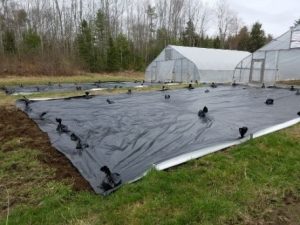
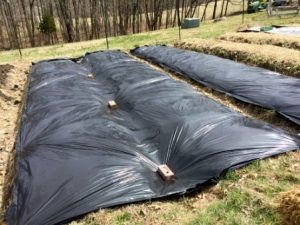
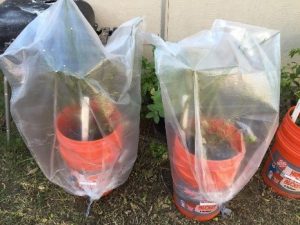
Tarping also prevent weeds from being blown or carried in, and most types listed above will block sunlight, starving weeds below.
In many cases, they’ll also create warmer soil conditions. That will keep our soil life active later and earlier in the season. (That’s both pro-con if pests start digging through them hunting our bugs.)
Mulching delivers many of the same benefits. Mulch comes in a wide variety of types and styles – whole leaves we rake from our trees, chipped leaves, leaf mold and compost we developed over the growing season, pine or grass straw, wood chips. Mulches can also be mow-down, crimp, or cold-kill cover crops.
Depending on our climate and whether we have “woody/hard” mulches (wood chips, whole leaves) or “soft/green” mulches (lawn trimmings, leaf mold, buckwheat and mustard covers), our mulches may break down sufficiently over the season to be tilled in or planted through come spring. Others may need to rake them off, furrow through them to expose soil for a planting pass, or use no-till methods, especially for the woodier types.
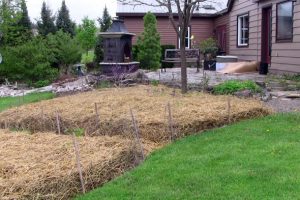
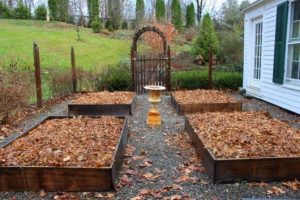
Some of the warnings about mulching are justified. In some cases, the “threat” is actually something I’m aiming for or consider a bonus – like pine and oak mulches increasing acidity in beds.
If you’ve had a booming acorn year (walnuts or pecans, too), you might want to do some winnowing so fewer end up planted in your nice, fertile garden soil to become a pest.
We definitely want to be very cautious if we’re chipping privet for mulches. Privet should be outlawed, and can survive some incredible horrors, then become a real pest. Discard any berries and sift through for small branches that escaped the chippers to avoid problems.
Also skip mulches made from trees that share diseases with our crops and ergot-infected grasses.
If we have major flea beetle or slug problems, some mulch types will exacerbate them and we may want to apply other measures to protect soils over the dormant season.
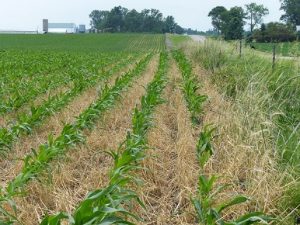
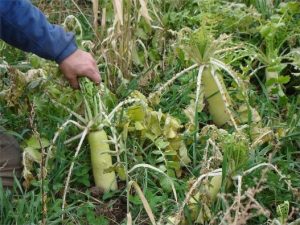
Cover Crops
It’s not as easy to bed down a whole field, especially late in the season. If there’s time in your growing zone yet, you may be able to get a cover crop in, or autumn-sow a cover that will come up in spring for some protection.
Buckwheat sprouts and grows fast, and can provide some die-down soil cover. Radishes and mustards are also quick and both have some additional benefits, especially if you’ve had pest problems earlier in the year, but consider your upcoming crop rotations with them.
Cover crops also apply to smaller beds, and there may still be time in some zones for things like autumn-sown, spring-harvest grains.
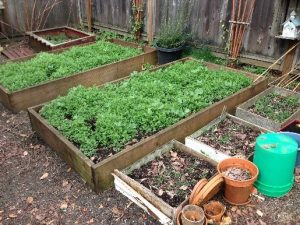
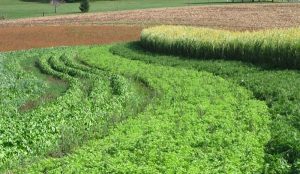
Tilled Plots
If you’re past the point of planting with a field or plot maintained with till cropping, there are still a couple of things that will help.
One, leave standing stubble unless it’s going to be a pest/disease host.
If it’s already bare, turned in, or has only sporadic plant matter, go ahead and get another till in. Double-cut across the face of contours to form exaggerated furrows (ridge-and-furrow irrigation style).
Versus a plot that’s already packed down flat and bare, both stubble and the undulating surface will slow and catch more of winter’s rains and any snowmelt, increasing infiltration and reducing erosion and nutrient runoff.
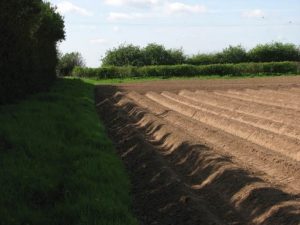
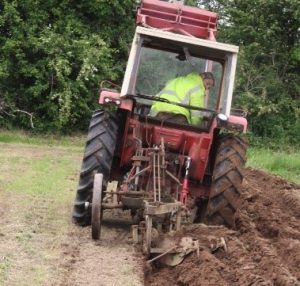
Exaggerated furrowing also means less spring flood inundation, creating warmer and less compacted soils that can be worked earlier in the year.
If the plot is small enough, go ahead and identify where you’ll be actively planting and where you’ll be driving or walking. Covering just your growing space may be possible, protecting that soil and decreasing the weed load. Any of the covers from tucking in smaller beds apply – weighted tarps and cardboard, compost, straw and leaf mulches.

Bedding Down Gardens
A few simple steps can have huge impacts on our gardens when they’re not in production, whether we’re going dormant for busy or arid or sweltering seasons, in part or in full, or for winter. Especially in areas where we get as many rain and thaw days as we have frigid days and persistent snow cover, protecting beds, planters, and row plots from weeds and runoff can help enormously when we’re ready to break ground again.
Working ahead to improve yields next year doesn’t have to be expensive. We can source coffee for fertilizer, all kinds of tarp replacements, and pine straw and leaves without spending a dime. In other cases, we can boost our productivity with $5-$25 testing.
Most bed-down practices also apply if we’re planning to expand our gardening next year, especially when it comes to soil testing, soil structure amendments, and lowering the weed loads we’re going to face. “An ounce of prevention equals a pound of cure” is pretty much universally true. It applies exponentially when it comes to our dormant and future garden spaces.

